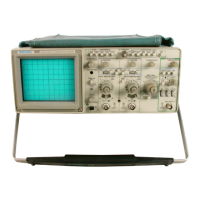Appendix C: Performance Verification
e. Press the TRIG POS button a second time to position the trigger
point to the middle of the display acquisition.
f. CHECK — The MIDTRIG point (T) is 5.12 divisions from the start of
the display acquisition.
g. Press the TRIG POS button a third time to position the trigger point
to the right of the display acquisition.
h. CHECK — The PRETRIG point (T) is 8.96 divisions from the start of
the display acquisition.
Q Step 8: Check Trigger Level Readout
b. Center the trace on the screen.
c. CHECK — The trigger readout is between -6 mV and +6 mV.
d. Connect the standard-amplitude signal from the calibration genera
tor via a 50 Q cable to the CHI or x input connector.
e. Set:
CH 1 AC-GND-DC DC
Trigger Mode NORM
f. Set the generator to produce a five division standard-amplitude
signal.
g. Adjust the Trigger LEVEL control for a stable display and center the
waveform on the screen.
h. Set the CH 1 VOL.TS/DIV switch to 10 mV for a 10 division display.
i. Vertically position the top of the waveform display on the center
horizontal graticule line.
j. Set the Trigger SLOPE switch to Negative (button in).
k. Rotate the Trigger LEVEL control clockwise until the triggering of the
waveform display becomes unstable.
l. CHECK — That the trigger readout is between 92 mV and 108 mV.
m. Repeat procedure for CH 2 using the CH 2 controls.
n. Disconnect the test equipment from the instrument.
a. Set:
Vertical MODE
CH 1 VOLTS/DIV
CH 1 AC-GND-DC
SEC/DIV
Trigger Mode
Trigger LEVEL
Trigger SOURCE
STORE/NON-STORE
CH 1
20 mV
GND
0.5 ms
P-P AUTO
Midrange
Vertical MODE
NON-STORE
(button out)
A*48 Appendices

